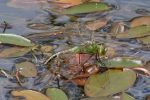I am spending some time working in Suffolk at present, and so was within range of Britain’s largest butterfly that I had observed on just one previous occasion. Though widespread across mainland Europe Swallowtail has been found here only within the Norfolk Broads historically, though there has been some colonisation of Sussex since 2013 (see here). The resident Norfolk butterflies are actually a sub-species britannicus that is slightly smaller and has more extensive dark markings than the continental counterpart.
The Norfolk Wildlife Trust’s Hickling Broad NNR (TG428221) comprises extensive areas of reed bed, pools and woodland adjacent to the largest area of open water in the Broads system. On arrival mid-morning I was directed by the visitor centre to a trail along which many tall thistles grow in the reed edge. Here I found several Swallowtail moving from plant to plant with their characteristic floppy flight. These certainly looked bolder and brighter than the continental form that I have experienced many times. They were a beautiful sight nectaring on swaying thistle heads and trying to keep their balance in a strong breeze. I could gladly have taken much more time photographing them but there was a lot of reserve to explore.
Having achieved the day’s main objective I quickly became preoccupied with the reserve’s abundant dragonfly life. Amongst these I gained pictures of Black-tailed Skimmer for the first time this season (below). Around a large pond near the reserve’s western edge, Emperor were engaged lazily in territorial jousts with fading Four-spotted Chaser and I eventually located one Green-eyed (or Norfolk) Hawker. There are plenty of the last-named at this site had I cared to search the many reed bed channels for them, but I’d done the species recently in Kent.
- Black-tailed Skimmer (fem)
- Female Emperor laying eggs
- Black-tailed Skimmer (male)
There were also some Darter species on the wing and amongst these was what I believe is my first British sighting of Red-veined Darter. This migrant is a frequent visitor to eastern and southern England and occasionally breeds. It took some time to secure a confirmation picture (above) after which I followed the “Bittern Trail” along the edge of Hickling Broad. From there cut paths led into the reed bed and I came across a cluster of Swallowtail again. These could have been the same butterflies I had photographed in the morning because when I got back to that first spot there were none to be seen.
It was now past 3pm and mindful of the 190 mile drive home, way beyond my usual range, I needed to leave. But hours could be spent productively at this fabulous site, getting better pictures of the Swallowtails, seeking out the Green-eyed Hawkers and more dragonflies; and there had been no time today to locate the reserve’s Common Cranes. Bittern? … Bearded Tit, Marsh Harrier … well we’ve got all those birds in Oxfordshire nowadays. I expect I’ll visit Hickling Broad again though sooner or later.








